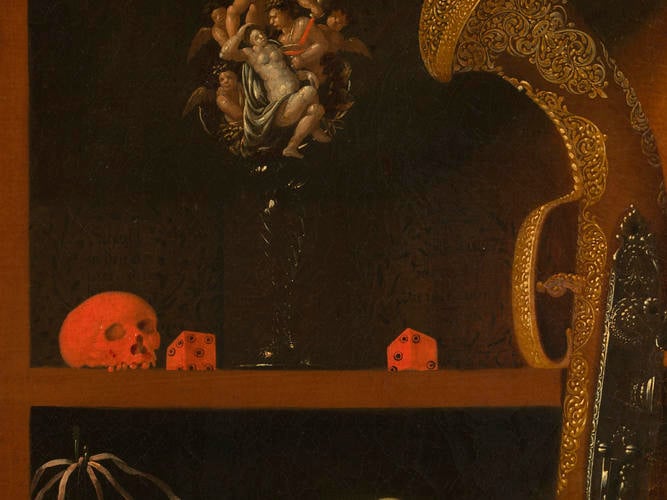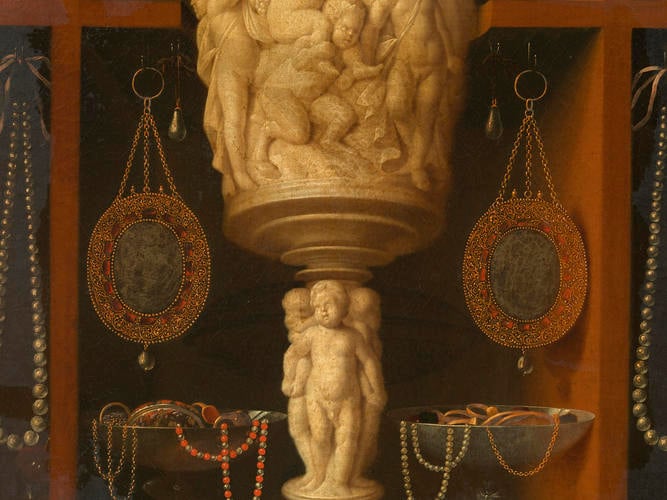A Collector's Cabinet 1664
Oil on canvas | 127.5 x 102.0 cm (support, canvas/panel/stretcher external) | RCIN 400918
-
Johann Georg Hinz worked in Altona, a suburb of Hamburg, and became famous for his pronkstilleven (sumptuous still lifes) in the manner of Willem Kalf. He may have known of Kalf’s work at first hand, perhaps visiting Holland in his youth, or through the Flemish flower painter Ottmar Elliger, who was in Hamburg during the 1660s.
In the late-sixteenth century Rudolf II's Kunstkammer in Prague was the most famous of its kind, comprising painting and sculpture alongside exotica, esoterica and precious objects. Inspired by the reputation of such collections, Frans Francken the Younger and Jan Brueghel had, in their paintings of around 1600, established a precedent for depicting fictitious collections constructed from real ingredients. Hinz works in their tradition, adding the trompe l'oeil effects of Cornelis Gijsbrechts, a Flemish painter who is known to have been in Hamburg from 1665 to 1668, before then becoming court painter in Copenhagen.Hinz's cabinet contains natural specimen - coral, ivory and shells - as well as the man-made objects which predominate. On the left we see a Nautilus Pompilus shell, and on the right a Strombas Gigas. An ornate ivory cup occupies the central compartment, depicting a Bacchic scene of cupids and satyrs, made by Joachim Henne in 1665 (now in a private German collection). We know Hinz must have seen the actual cup, rather than a mere two-dimensional reproduction, as he repeats different aspects of it throughout a number of paintings. A flanking ivory statue shows Hercules prising the jaws of the Nemean Lion and an ivory tankard depicts further drunk cupids. There are also two silver tazza (elegant flat-bottomed drinking cups), two watches, two guns, and two sumptuous vases. An ornate closed chest, inlaid with jewels, completes the intriguing assemblage.
Signed and dated 1664 on the closed chest, the Royal Collection's Collector's Cabinet is the first of its kind. There are four replicas of the Royal Collection painting, one of which, signed and dated 1666, is at Schloss Reichenbach, with others in Sanssouci, Schloss Köpenick, and the Brukenthal Museum. Hamburg's Kunsthalle, the Rijksmuseum and the Schloss Gotha Museum hold examples of a similar series of cabinet painting, though with different objects and eleven compartments instead of fifteen. There are further types of Hinz cabinet painting in the Statens Museum for Kunst, Kopenhagen, and another in a French private collection. The painting's date of 1664 is puzzling. Hinz's cabinet painting is supposed to have been inspired by Gijsbrecht's documented stay in Hamburg between 1665 and 1668. The ivory cup is said to have been made in 1665. Either these dates are wrong or Hinz has mis-dated his own work.
Hinz's cabinet is clearly a fabrication. The objects, either taken from reality or from drawings, have been gathered together to form his own artificial collection. The artist may have been imspired by the Wunderkammer of the age, such as that of Johannes Rist in Wedel, the Counts Palatine, Hamburg, Lüneburg or Gottorf Castle in Schleswig-Holstein. Unfortunately, no evidence exists of Hinz's having seen any of these collections, but they all lie within easy reach of Hamburg. Certainly, the location of Hinz's cabinet paintings demonstrates their appeal to princely European collectors: the Royal Collection painting being an obvious example. In the Royal Collection painting an inscription on the glass trophy reads: Auf heijl vom grossen / Keijser / Und grosser Norden / häuser, meaning "salutations from the great Emperor and great northern houses". There are further inscriptions around the trophy that are impossible to fully decipher due to fading, but which certainly contain the word schlaft. Owing to their proximity to the skull, dice, gun and watches, it is probable the inscriptions relate to vanitas themes, ruminations on mortality and the shallow transience of worldly possessions.
Signed and dated on the bottom of the chest Georg Hinz, fc Anno 1664.
Provenance
First recorded in the Coffee Room at the Queen's House (Buckingham Palace) in 1819 (no 779)
-
Creator(s)
(nationality) -
Medium and techniques
Oil on canvas
Measurements
127.5 x 102.0 cm (support, canvas/panel/stretcher external)
167.5 x 142.3 x 5.7 cm (frame, external)
Category
Object type(s)
Alternative title(s)
A cabinet
A "Kunstkammer"










